This Spelt Buckwheat Loaf, leavened with a rye starter and filled with Caramelized Onions, is an adapted version of the Caramelized Onion Bread from the book Ben Cuit.
Tanna chose this aromatic bread for the 8th Anniversary of the Bread Baking Babes. I’m delighted to celebrate their 8th Anniversary with my rendition of the “Ben Cuit” bread.
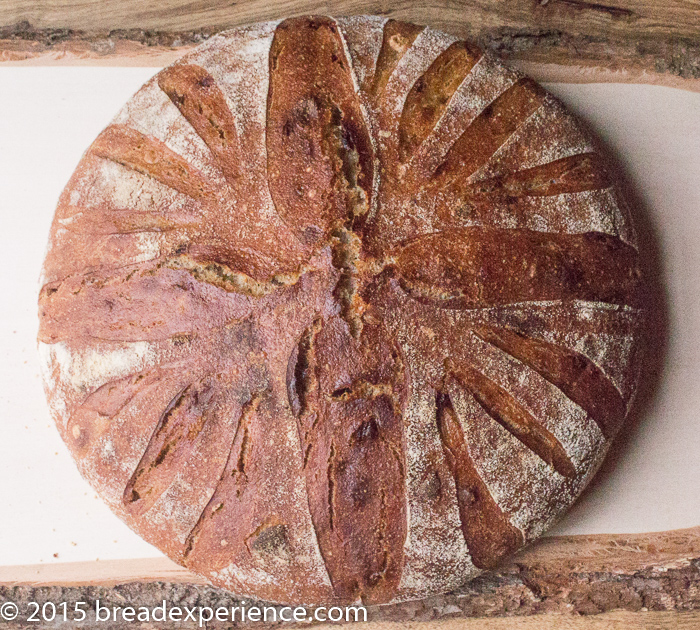
I enjoyed the depth of flavor and the texture of this loaf. I served it for dinner with olive oil and spices for dipping. My dinner guest liked it so much, he went back for seconds, twice. He was so intrigued by the crust and the delicate crumb on the inside.
I just had to smile because until recently, my friend would say that he only thought of bread as something to hold together a sandwich. Little did he know that I was slowly bringing him into the experience. I’ll make him a bread lover yet!
I would’ve sent the rest of the loaf home with him, but I didn’t have time to get a crumb shot before dinner. However, when I sliced the loaf, I knew I had to get a shot of those lovely holes. In hindsight, I should’ve made two loaves, but don’t worry, he won’t miss out. I plan on serving slices of this bread with bruschetta for another meal.
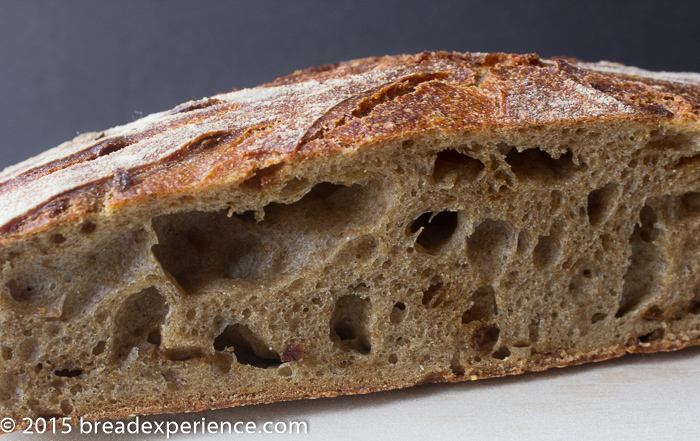
This bread is made with a rye starter; however, it utilizes a pinch of yeast as the fermenting agent rather than sourdough. I used wholegrain rye instead of white rye so the consistency reminded me more of a biga (stiff dough) than a starter.
I only wanted one loaf so I adjusted the formula accordingly. The loaf from the book was shaped like a batard, but I made a round version so I could try a new scoring pattern. I baked it in a bread cloche rather than on a baking stone. In addition, I sauteed my onions in butter for about 15 minutes rather than caramelizing them for 1 1/2 hours, but the onion flavor was still quite delightful.
I took a lot of liberties with this bread. If you want to view the formula and instructions for the version made with white flour and fully caramelized onions, refer to Tanna’s post. If you like whole grain rye, buckwheat, and spelt, and a little less time spent caramelizing the onions, please check out my version below.
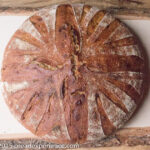
Caramelized Onion Spelt Buckwheat Loaf
- Yield: 1 Medium Loaf 1x
Description
This Spelt Buckwheat Loaf, leavened with a rye starter and filled with Caramelized Onions, is an adapted version of the Caramelized Onion Bread from the book Ben Cuit.
Ingredients
Rye Starter (20% of total flour)
- 100 grams whole grain rye
- generous pinch of instant yeast
- 100 grams water about 60 degrees F.
Final Mix
- 340 grams all-purpose spelt flour (85%)
- 60 grams buckwheat flour (15%)
- 11 grams fine sea salt
- 1/8 teaspoon instant yeast
- 280 grams water at about 60 degrees F. (70%)
- 40 grams honey
- 20 grams (~1 Tablespoon) unsalted butter, at room temperature
- 40 grams sauteed or caramelized onions
- rice flour or semolina flour for dusting the proofing basket
Instructions
Evening Day 1 – Create the Starter
- Whisk together the rye flour and pinch of yeast in a large bowl.
- Pour in the water and mix using a Danish dough whisk, wooden spoon or your hands. Mix until thoroughly combined.
- Cover with plastic wrap and let the starter sit at room temperature for 10 to 14 hours. The starter is supposed to be at its peak at 12 hours but can be used up until 14 hours or possibly longer if it’s cold in your kitchen.
Day 2 – Mix the Final Dough:
- In a separate bowl, whisk together the flours, salt and yeast. Set aside.
- Pour about half the water around the edges of the starter to release it. Add the remaining water and the honey and use the back of a wooden spoon or a Danish dough whisk to break up the starter and disperse it throughout the water.
- Add in the flour mixture and mix until the flour is thoroughly combined.
- When the dough becomes too stiff to mix with the dough whisk or wooden spoon, use wet hands and a plastic dough scraper to work the dough. The dough will be sticky.
- Fold the dough over itself several times in the bowl to strengthen the dough. Form into a rough ball and place seamside down in a clean bowl or scrape down the sides of the bowl with the dough scraper.
Bulk Fermentation:
- Cover the dough with a clean kitchen towel and let it rest at room temperature for 45 minutes.
- Perform the first stretch and fold by removing the dough to a floured work surface and gently stretch it into a rough rectangle. Stretch the dough up from the left and fold it onto itself, then repeat from the right, top and bottom. Tuck the dough under and place it seamside down in the bowl. Cover the bowl and let the dough rest for 45 minutes.
- Perform the second stretch and fold in the same manner as the first one. Return the dough to the bowl, cover and let rest for 45 minutes.
- For the third stretch and fold, carefully spread the dough into a rectangle. Using your fingers, pinch the butter into small pieces and distribute them evenly over the dough. Spread the butter across the surface using a spatula or your fingers. Distribute the onions over the top.
- Roll the dough up into a tight roll starting from the end closest to you. The dough will be seam-side down. Turn it over and press to flatten it a little bit. Fold the dough from the left and the right and then knead a little bit to work in the butter. Shape into a round and place seam-side down in the bowl. Cover and let rest for 45 minutes.
- Perform the final stretch and fold in the same manner as the first fold. Return the dough to the bowl, cover and let it rest for 45 minutes.
- Heavily dust a lined round proofing basket with a mixture of rice/white flour or semolina/white flour. Shape the dough into a tight boule and place seam-side up in the proofing basket.
- Cover tightly with plastic wrap and a kitchen towel and place in the refrigerator to chill for 12 to 18 hours.
Day 3 – Bake the Loaf
- Preheat the oven with a cloche or Dutch oven inside to 450 degrees for at least 30 minutes.
- After the oven is sufficiently preheated, remove the basket from the fridge. You’ll bake the loaf cold without warming it up to room temperature.
- Carefully remove the preheated cloche from oven and place it on a heavy towel or pot holder. Remove the lid to another towel or pot holder. Sprinkle the base of the cloche with cornmeal or semolina.
- Gently flip the loaf out of the basket and onto the base of the cloche seam side down. Score it in the pattern of your choice.
- Place the cloche in the oven and cover with the lid. Bake in the preheated 450 degree oven for 15 minutes. Remove the lid, lower oven temp to 425 degrees F. and bake the loaf without the lid for an additional 10-15 minutes or until it is crusty on the outside and sounds hollow when thumped on the bottom.
- Remove the loaf to a wire rack to cool completely before slicing and serving, at least 4 hours, but ideally 8 to 24 hours, if you can wait that long.
- Category: Spelt Buckwheat Loaf
- Cuisine: Artisan Bread
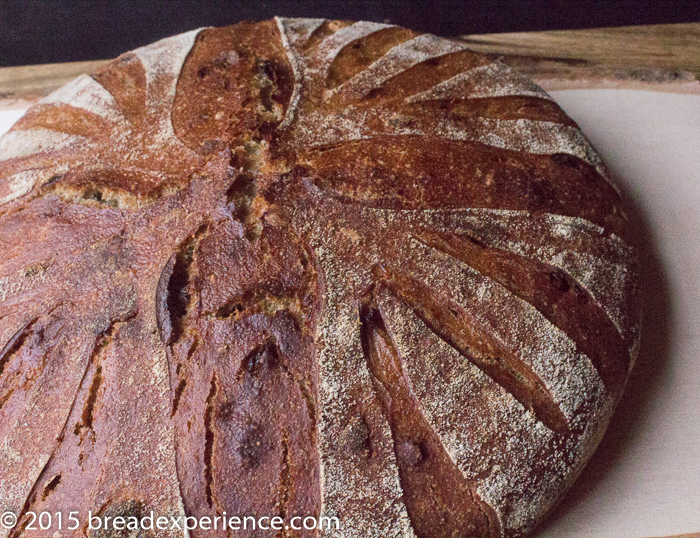
Tanna is the host kitchen for January for the Bread Baking Babes. Details on this month’s bake can be found on Tanna’s post.
I invite you to bake this loaf and tell us all about it. Enjoy this bread and celebrate our 8th anniversary with us as a Bread Baking Buddy. Have fun baking.
And please do check out the bread from the other Babes made. Links below.
Happy Baking! And welcome to our newest babe, Kelly of A Messy Kitchen.
Cathy
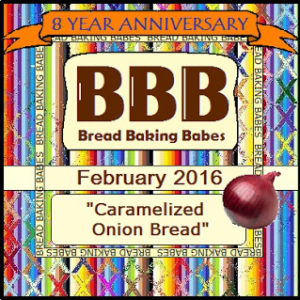
– Karen
blog from OUR kitchen – Elizabeth
Bread Experience – Cathy
All Roads Lead to the Kitchen – Heather
Judy’s Gross Eats – Judy
Karen’s Kitchen Stories – Karen
My Diverse Kitchen – Aparna
My Kitchen In Half Cups – Tanna
Notitie Van Lien – Lien
Thyme for Cooking – Katie (Bitchin’ Bread Baking Babe Bibliothécaire)
A Messy Kitchen – Kelly
Life’s a Feast – Jamie
Ilva Beretta Food Photography – Ilva
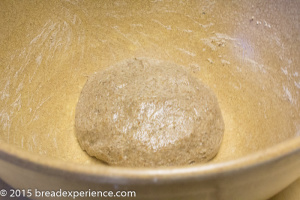

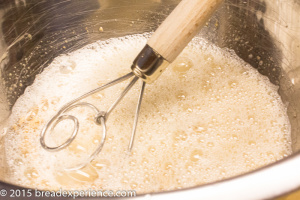
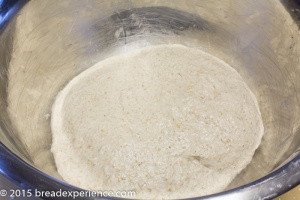
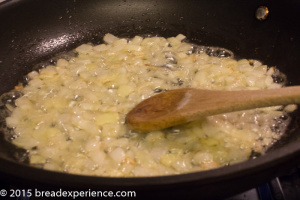
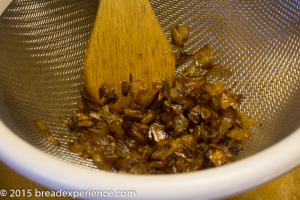
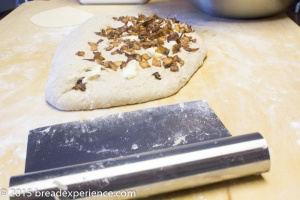

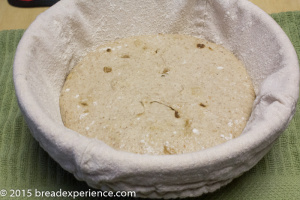
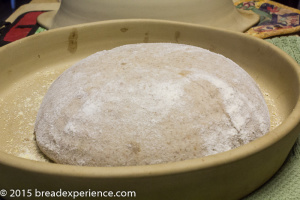
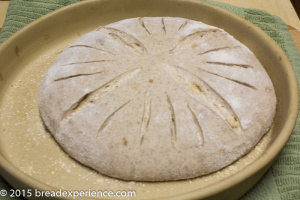
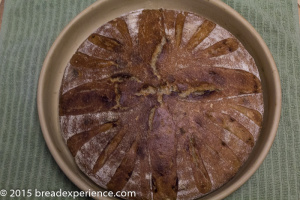
Elle says
Super scoring and what a great dark crust from baking in the cloche. The holes are truly artisan and I can just see slices turning into yummy bruchetta!
Cathy says
Thanks! Yes, I’m looking forward to the brushetta.
Karen @ Karen's Kitchen Stories says
Your crust looks amazing and those holes!! Wow!!I totally related to not sharing so I can grab a photo! Ha ha!
Cathy says
Thanks Karen! The things we do to get a shot, right!
Kelly says
So pretty! *sigh* I need to save up for a brotform and a cloche… 😀
Cathy says
Thanks Kelly! In the meantime, you can use a bowl covered in a heavily-floured towel. And a baking stone with a metal bowl for the lid also works.
Elizabeth says
Your loaf looks wonderful. The scoring is stellar and yes! The irregular holes in the crumb are fabulous, aren’t they? I love it when the holes are shiny.
Good idea to bake the bread in a cloche – I wish I’d remembered to do that.
Cathy says
Thanks Elizabeth! Yes, I was quite pleased with the holes in the crumb.
Baking Soda says
Love the scoring pattern, like a sunflower! Wish I had thought of baking in a cloche! Lovely crumb as well, it’s beauty all over!
Cathy says
Thanks Karen! Sunflower, I like that! I’m ready for Spring.
Katie Zeller says
Oh My …. Your loaf is to pretty and round and lovely! I used to have a cloche….. wonder where it is.
Well Done!
Cathy says
Thanks Katie! It was delicious! You need to find your cloche.
Tanna says
You’re sending people to me for the “official” recipe. I’m not sure we ever really have an official recipe being as how everybody seems to take off in our own ways.
I am in awe of your holes! My the are grand! The scoring does indeed resemble a gorgeous sunflower!
My husband still craves white wonder bread with baloney but he has over many years come to understand that is not really bread and has a real appreciation for the real deal. I love it in a restaurant when he tries the bread offered and finds it woefully wanting.
Cathy says
Yea we pretty much do change the recipes to suit our needs. I’ll revise my post. It is nice when real bread is appreciated. So glad your husband’s bread tastes have evolved.
Lien says
LOvely holes! I looks a bit like the inside of focaccia. Very nice. Happy anniversary Cathy
Milla says
This looks really lovely. Like a true piece of art.
Cathy says
Thanks Milla! It’s a great loaf to work with.
Joyce says
Hi,
I have an active rye starter. Can I substitute 200 grams of that for your starter? Should I still use the yeast? Will I have to extend the proofing times? Sorry for all the questions but I am very new to sourdough baking. Thanks Joyce
Cathy says
Hi Joyce, those are all great questions. Yes, you can substitute your active rye starter instead of the “yeast” starter. If your starter is fed and ready to go, then you probably won’t need the yeast, but I would give it a little longer fermentation to ensure it is sufficiently developed. Let me know how it goes.
Bread & Companatico says
lovely loaf Cathy!!
Cathy says
Thanks Barbara!